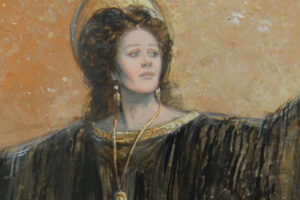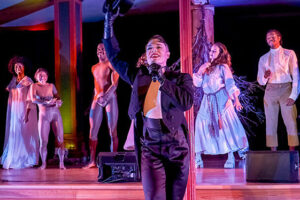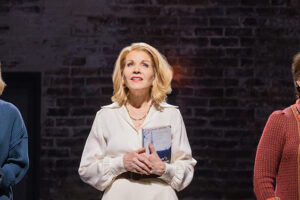

Combined with Philippe Jordan’s fleet, intelligently tinted and beautifully balanced vision of the score, and a Metropolitan Opera Orchestra playing with superb technical finish (ignoring the few occasional brass flubs, which registered as minute pulses within these scores’ 14-plus hour tapestry), you have the requisite elements for a Ring that delivers spectacularly on the musical front.
Despite this embarrassment of musical riches, one also ought to consider the theatrical facet that the Met chooses to present in this second iteration of Robert Lepage’s production. The thesis of Lepage’s concept, rather than expounding on a set of philosophical angles or fascinating dramatic undercurrents, centers on an ambitious engineering marvel intended by the director to function as a multipurpose storytelling aid.
At its best, Ex-Machina’s array of movable planks can deliver moments of awe-inspiring stagecraft. Considered within the context of Wagner’s rich mythology however, the machine ultimately fails to provide any lasting, distinctive artistic impact on the ongoing artistic conversations about the Ring.
Ex-Machina’s tech is not without its virtues. When deployed in the most creative fashion, the Machine could simulate the most visually arresting scenes within the libretto that are difficult to achieve without its three-dimensional translational capabilities. I think of the remarkable transitional episode that Wotan and Loge take to and from Nibelheim, wherein stunt doubles cross an array of staggered planks to either end of the vast Met stage.

But moments that capitalize on the machine’s full potential are more the exception rather than the norm. When acting as a backdrop for the tetralogy’s various acts, the Machine appeared more like an expensive, multi-planar projection medium for a concertante performance of the Ring with singers dressed in Party City Norse god/Game of Thrones costumes.
If I found the machine effective in scene three of Rheingold, the first act of Walküre and the first two acts of Siegfried, it was largely because the sets provided a neutral canvas for talented singers to flesh out Wagner’s drama. If you have theatrically inclined singers like Konieczny and Volle imparting vibrancy and Lied-like nuance onto their lines, you can park them in front of a blue screen of death and the beauty of the Ring’s libretto will still emerge.
Elsewhere, the transformations of Lepage’s set proved either puzzling or intrusive. Lepage appears to fundamentally misunderstand the richness and the layers of meaning behind Wagner’s libretto, reading the Ring more for spectacle and technological showmanship as opposed to probing the interactions and the profound text that govern the characters’ evolution.
The director also seems to exhibit little understanding of a staging’s ability to reflect the symbols and motifs that occur throughout the Ring operas. One could make a case for cleverly using the machine’s translational versatility with lighting and projections to convey these intra-score elements onto the Machine.

In Rheingold, critical episodes like Alberich’s theft of the gold and the ascent of the gods to Valhalla feel neutered and hollow (even if the gods’ celebration of Valhalla ought to feel hollow, one should still obtain a sense of grandiosity and pomp about it), and Loge’s character loses the playful, flickering aspects of his character as he spends most of the opera tethered to a rope.
Walküre’s most glaring issue stems from Lepage’s misuse of an ocular object to visually accompany Wotan’s great monologue. And of the quartet of Ring operas, it was Götterdämmerung that suffered most from Lepage’s inability to create a compelling spatial setting for his singers.
To deal with the Gibichung dominated plot, Ex Machina projects ultrasmooth wood patterns onto the machine, giving the Met stage the look of a sterile Scandinavian Bang and Olufsen showroom, perhaps the most uninspired deployment of the screensaver aesthetic so common in this production. And the less said about that inane, anticlimactic cataclysm, the better.
Wagner’s Ring was the epicenter of multiple important aesthetic shifts in the art of staging opera as theater. Apart from the fact that Wagner’s Bayreuth Festival has shepherded Rings that have revolutionized the Regisseurs’ craft, the rich material contained in Wagner’s magnum opus has over the course of its life inspired artists and directors to reimagine the saga with the most inventive use of technology.

I do not fault Lepage for exercising his use of modern engineering or applying a literalist philosophy on this entire affair. Rather, I find that his lack of imagination in directing the Ring’s compelling characters and the disconnect between his vision and the score’s fine details ultimately scuttles this production.
Some people lament that Otto Schenk’s literalist fairytale adaption of the Ring was replaced by another less inspired, equally literalist staging. I will lament a different missed opportunity: in the early 2000s, there were rumors that the great and innovative Herbert Wernicke was in talks with the Metropolitan Opera to develop conceptual art for a new Ring cycle.
His untimely death unfortunately made that an impossibility, depriving audiences of the director’s rich theatrical vocabulary and the striking spatial ideas that could have accompanied that production.
Enough talk about the machine; let’s talk about the musicians.
The second cycle for the Metropolitan Opera’s 2019 Ring revival boasts a remarkably starry roster of Wagnerian A-listers that reads almost like the cast lists for deluxe studio recordings of a bygone era.
While Christine Goerke’s Brünnhilde is a constant throughout all the cycles, the role of Wotan was initially shared by Greer Grimsley and Michael Volle, and that of Siegfried by Stefan Vinke and Andreas Schager. The scheduling for the serial Ring was also spaced out over the span of nearly two months, disrupting the sense of continuity so critical for absorbing the Ring’s musical and philosophical material within a short time span.
The cycle I attended is the first of two that the Met will mount within the space of a week and features exclusively the Wotan of Volle and Siegfried of Schager.
I’d already written in length about the virtues of this cast in a different Parterre thread, but I’d like to revisit a few of my recollections here. My purpose for attending this revival of the Ring was to experience the performances of Volle, Schager and Konieczny.
All of these artists delivered powerful musical and theatrical readings of their characters, and for me redefined new standards of interpretation comparable with these roles’ greatest exponents in the discography.
Volle’s Wotan marks one of the most laudable artistic triumphs of Cycle II. His impressive baritone fills Wagner’s phrases with focus and clarity and captures the broad range of tints and dynamics needed to project the character’s layered psychology.
Volle’s inclusion in this Rheingold poses a truer antipode to Konieczny’s searing Alberich—a fascinating shift in power dynamics when compared to the first performances of the prologue. His Wotan would later find its poetic peak in Die Walküre, where he builds up the character’s episodes of desolation with the fine brush of a Lieder singer.
Of all the Wotans I’ve experienced live, Volle’s musical and scrupulously prepared monologue strikes me as the finest for his beauty of sound and his ability to extract textual riches from the libretto. When he narrates the drama, one cannot help but be transfixed and listen to him with rapt attention.
One phrase that devastated me occurred near the end of his monologue, when he chooses to relinquish all that he had built up to the Nibelung’s son. Volle had carefully unfurled the monologue beginning with an internalized whisper, building in intensity until that crushing statement of resignation.
Later, his farewell to Brünnhilde is rendered so lyrically and tinged with such sorrow that his singing brings a tear to one’s eye. Volle caresses these phrases with such sincerity, and one really believes that he was personally bidding a beloved daughter farewell on the Met stage.
As the Wanderer, Volle inhabits the world-weary character’s wit and resignation and delivers some of the opera’s most riveting dialogues. His riddles with Mime are crafted with such rhythmic vitality, and his final scene with Erda beautifully depicts the moving close of his character’s arc, a making peace with fate if you will. I have few doubts that Volle will be generously recognized by history for the artistry that he can draw out of this most complex of characters.
Konieczny’s Alberich is a tour de force display of Wagnerian villainry. In his creation of the character, Konieczny rarely resorts to caricature or simpering victimhood, here presenting Alberich as a corruptive, almost malevolent force in the Ring universe. All his scenes throughout the cycle completely engage the listener for the potent immediacy of his vocal acting.
His damning curse in Rheingold is laced with such venom that it chills one’s spine, while the laughter that immediately follows is simply disturbing. His scene with the Wanderer also reminds the listener of his singular, monomaniacal will. When we finally encounter him goading his son to do his bidding, we see him for the sinister alpha manipulator that he is. Konieczny’s vocal artistry is so convincing that he convinces the listener that he is the Ring’s true villain.
Schager’s tenor is a miracle of heroic singing. The voice sounds simultaneously warm, focused, powerful, and beautiful, almost as if a clarion Tamino were traversing Wagner’s impossible music with lyrical ease. During his eponymous opera, I often found myself with my jaw agape, in awe of the spectacular vocalism I was hearing from the Met stage.
Tenors who sing Siegfried normally are commended for merely getting through this marathon of a tenor part. Schager not only conquers these vocal lines beautifully, but also infuses the role with an abundance of energy and poetry. On hearing Schager, I felt that I had discovered the Siegfried of my dreams—the wandering young poet in search of an identity and companionship.
While Schager’s forging song and the climactic love duet are no doubt impressive for his seemingly endless reserves of voice, I found myself particularly drawn to the poetry of his more contemplative episodes. The forest soliloquy and the moments leading to Brünnhilde’s awakening strike me as highlights for bringing the listener into Siegfried’s internalized loneliness and his infectious sense of wonder.
Although Götterdämmerung offers Schager fewer opportunities to display his vocal pyrotechnics, I thought his performance of the hero incredibly commendable and moving. Act 3 was a triumph for his character—his mimicking of the Forest Bird’s songs soars with vitality and freedom, while his tragic death scene unfurls with some of his most expansive and poetic phrases.
Siegfried’s final reverie often feels hollow due to the character’s unsympathetic qualities, but Schager’s artistry ultimately moved me as sang this paean to his true love.
Beyond these three artists’ towering performances, I also found much to enjoy with the other members of the Met’s A-List Ring cast. Stuart Skelton and Eva-Maria Westbroek gave impassioned readings of the Wälsung twins and delivered a sensational opening act to Die Walküre.
Wendy Bryn Harmer was a standout among the supporting cast, pouring forth streams of beautiful, focused tone whether she played Freia, Ortlinde, or the Third Norn. So distinctive and secure was her vocalism that I often wondered why she wasn’t afforded the opportunity to essay a bigger role like Gutrune.
Michaela Schuster, though not as vocally refulgent, developed Waltraute as one of this Ring’s more compelling supporting characters through her incisive phrasing of Wagner’s text. Günther Groissböck impressed while fielding his handsome bass as the lovelorn Fasolt and the honor bound Hunding, while Dmitry Belosselskiy rumbled and boomed as Fafner.
Although Eric Owens at times disappointed for the smaller grain of his voice, his more pensive turns as Hagen enabled him to draw many valid artistic ideas about his character. And what incredible Norns the Met has for this revival! Ronnita Miller’s beautiful, shadowy contralto resonated beautifully in the Met auditorium during this inspiring scene of Wagnerian exposition.
Christine Goerke’s Brünnhilde is one of the last points that I’d like to cover before closing my thoughts on this article. Ever since her justifiably celebrated performances as the Dyer’s Wife and Elektra, Goerke was propelled to fame and was touted as one of our time’s dramatic sopranos of promise.
When I heard her take on the Walküre Brünnhilde in Chicago, I admired her powerful vocalism and the interesting interpretive and musical choices that she could execute with her prodigious, voluptuous sound. However, the voice isn’t quite what it used to be.
The trio of Brünnhilde’s I experienced at the Met were vocally inconsistent—her singing was at times unfocused and disrupted by a loss of volume, her line could be saddled with intonation issues, and her modes of vocal production could vary from a different set of notes to the next.
Of her three operas, it was surprisingly the Walküre Brünnhilde—a role that ought to sit more comfortably in Goerke’s tessitura—that I found most disappointing. Her performance during the Todesverkündigung illustrates my current reservations about her vocal production.
During this transformative scene, her voice seemed to shift emission from a robust, almost vulgar chesty sound, to her burnished middle voice that could occasionally drop in volume, to a tremolo driven passaggio, and finally to her diminished top. These inconsistencies rob her Brünnhilde of the nobility and profundity I normally associate with the great interpreters of this majestic scene.
It also didn’t help that Goerke tended to overplay the teenage girl aspect of the most youthful Brünnhilde, exhibiting a proclivity for bolder gesticulations and sweeping stage movements as opposed to gestures of economy that I feel would create a more palpable dramatic impact.
Goerke is by no means a bad Brünnhilde. She is a sincere and committed artist and is securer than many who have recently undertaken this heroic triumvirate of roles. However, her vocal issues at times impair her ability to overwhelm the listener with Wagner’s powerful music and serve to further highlight her tendency to indulge in maudlin theatrics.
If she could address her vocal issues and consistently uphold the impressive standard she brought to the second act of Götterdämmerung, I believe that she could create a credible Brünnhilde. In that scene, Goerke was able to pour out sound reminiscent of her better years while delivering searing indictments against the men who wronged her. If her technical form in this act had set the tone for the rest of the cycle, I wouldn’t hesitate to regard her interpretation as a triumph.
Philippe Jordan, the Ringmaster assigned with the task of overseeing this sprawling enterprise, shaped an orchestral reading of the Ring marked by swift tempi, luminous textures and balances, and flowing lyricism. While Jordan doesn’t furnish his orchestra with as resonant of a bass line, there remain many fascinating contrapunctal elements that emerged from the pit.
Jordan’s Ring resembles the more fluid orchestral interpretations led by the likes of Wolfgang Sawallisch and Marek Janowski. One can hear in his orchestra a multitude of finely calibrated instrumental voices, ranging from harps, to reeds, and strings, all tinted by the Met’s excellent players to convey various moods and themes contained in the Ring dramas.
The propulsion can sometimes seem a bit driven (e.g. the first scene of Das Rheingold), but overall this is a Ring where the line rarely sags, and the drama never flags. The leitmotivs still emerge with astonishing clarity in the house, although one can quibble that the swift tempi can sometimes prevent certain themes from blooming.
While this isn’t a Ring that echoes the epic and grand readings by Wilhelm Furtwängler, Christian Thielemann or Herbert von Karajan, this remains a highly accomplished and beautiful performance by Jordan and the Metropolitan Opera Orchestra.
My conclusions: this is a revival with many admirable musical values, and features some of the most talented artists in Wagner today. The staging remains uninspiring, but it also does little to prevent great singers from creating a compelling depiction of Wagner’s Ring.
Photos: Ken Howard
























Comments